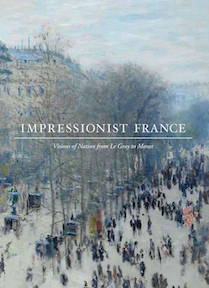By Svetlana Alpers
If you care about France this is a book for you. But it is also a book for you if you are interested in the way pictures—paintings, but also photographs—can shape a nation’s vision of itself to itself and to others. The exhibition was mounted by a pair of museum curators in St. Louis (Kelly, painting) and Kansas City (Watson, photographs). It featured work lent almost entirely by American collections. The American love of France is clearly in evidence. Partly because of the articulate texts and partly because it concerns many photographs which are appropriately displayed on the printed page, the catalogue is a fine thing to have to hand even if you missed seeing the exhibit.
Put aside the misleading“Impressionist” of the main title, and you will discover a world of images you probably do not know, that were mostly made mostly under Napoleon III (1851-70)—though the exhibition extends longer to include the great Paris International Exposition of 1878. It was a time of conscious nation-building: there were 2,000 miles of railroads in France in 1850 and almost 10,000 in 1870. It is a period described here as a golden age for French photography. Replicable photographs had just come into their own in France. In 1851 the state established a Mission héliographique which sent five photographers out to record the country new and old. Further, in 1861, Édouard Baldus made striking albumen prints along the route of the new railroad from Paris to Lyon and the Mediterranean, while Auguste-Rosalie Bisson recorded the Alps in the newly won French territory of Mont -Blanc. The tonal range of their black and white images is astonishing, as is the framing.
The thrust of the essays in the catalogue is to present painting and photography as joint contributors to the making of the new vision of France in the 19th century. But in the plates of this book—which are perhaps kinder to small black and white photographs than to large colored oil paintings—one is tempted to compare and contrast the skills and effects of the two mediums. Photography comes out remarkably well. We have been accustomed to salute the painters of the 1870s—Pissarro, Monet, and also on occasion Cézanne—who on occasion let industrial sites into their paintings. But the photographs do it more naturally, one might say: one new technology contending with and saluting another.
But the truly surprising success of photography is in the genre of landscape. It is a moment when the homeland replaces the old passion for Italy among French artists. But it is the photographers not the painters, at least at first, who make the most of it. Among the pleasures are Eugène Cuvelier’s extraordinary photographs of trees and rocks at Fontainebleau. He apparently printed very few, each with great individuality. He was an amateur first trained, like so many photographers then, as a painter and he worked on his own. Charles Nègre’s striking vertical photograph of a street in his hometown of Grasse strikes one as a precursor of the arresting array of a Provencal village as painted by Cézanne or, following him, by Picasso.
In writing of a soft-toned river scene by one Camille Silvy, Watson describes it as among the earliest examples of ambitious landscape photographs conceived and critically acclaimed as high art. But one might object about the privileging of this photograph as high art over images by Cuvelier and Nègre. Perhaps, against the painterly orientation of critics of that day, it is not a matter of photography rising up to be an art equal to painting, but rather the sense that there is a different art native to photographs.
Svetlana Alpers, an artist, critic and renowned art historian, is professor emerita of the history of art at the University of California, Berkeley and a visiting scholar in the Department of Art History at New York University.




